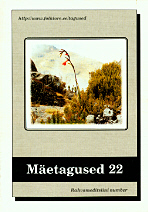Muusikamaagiast muusikateraapiani
From Music Magic to Music Therapy
Author(s): Eha RüütelSubject(s): Customs / Folklore
Published by: Eesti Kirjandusmuuseum
Summary/Abstract: It is believed that music has been used to treat people since the Palaeolithic Period. In the time when illnesses were attributed to supernatural phenomena, the instruments of making sound where used to create connection with magic powers. When people learned to give rational explanations to illnesses, they began to consider the effect of music as balancing emotional life and bodily processes. In ancient Greece and Rome, practising doctors gave suggestions on music therapy, but it was considered an alternative treatment. Relying on the effect modes and rhythms has on emotions, music was considered especially suitable for dispersing passionate desires. Different music was suggested for different illnesses. Through ages it has been recommended to engage in music activities supporting ethos in order to stay healthy. The discovery of the methods for recording sound at the end of the 19th century expanded the range of therapeutic use of music. Music was regularly used in medicine in order to control moods, decrease anxiety, and promote relaxation. Music was introduced into dental procedures, midwifery and operating theatres. In contemporary medicine there are three major ways of applying music: supportive to medical treatment (e.g. music listening during a procedure to diminish anxiety and to promote relaxation); equivalent to treatment (e.g. singing in the case of respiratory problems); primary treatment (e.g. listening to music to achieve pain relief). In parallel with application of music in medicine, music therapy developed into an independent field, which according to Kenneth Bruscia, is a systematic process of intervention wherein the therapist helps the client to achieve health, using musical experiences and the relationships that develop through them as dynamic forces of change.
Journal: Mäetagused. Hüperajakiri
- Issue Year: 2003
- Issue No: 22
- Page Range: 63-79
- Page Count: 17
- Language: Estonian

